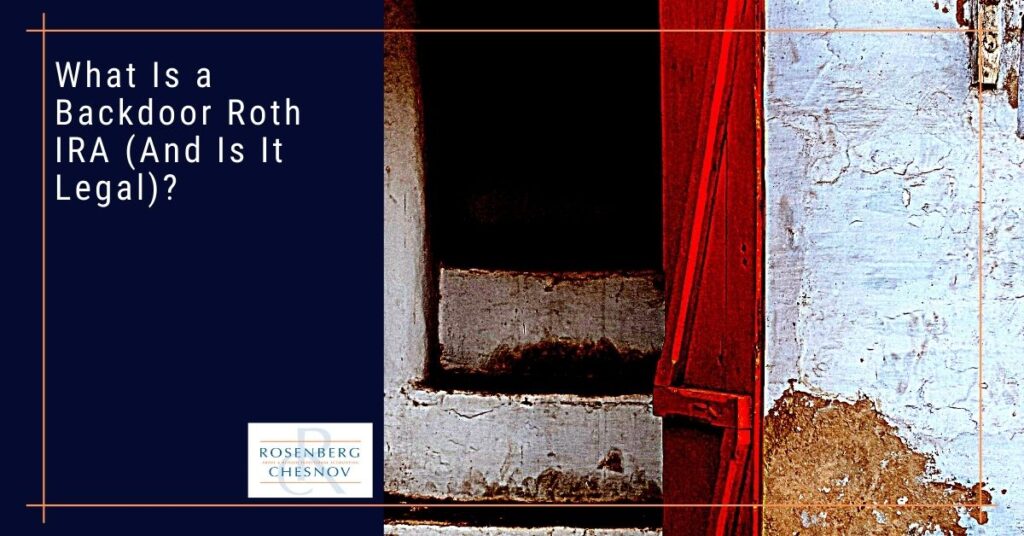Why Roth IRAs are attractive
In our post, What You Need to Know About Individual Retirement Accounts, we cover the different types of retirement accounts in detail. But to summarize here, the most significant two benefits of the Roth IRA are:
- Your money grows tax-free. You must pay tax on your contributions (when you make them or convert), but you do not pay taxes when you withdraw the money.
- There are no minimum distributions.
The challenge is the income limit: If you earn more than $125,000 as an individual ($198,000 as a couple), the allowable contribution decreases. If you make more than $140,000 as an individual ($208,000 as a couple ), you cannot contribute directly to a Roth IRA at all.
But the Backdoor IRA conversion is still an option at any income level.
How the Backdoor Roth IRA conversation works
First, check that the brokerage or bank that holds your IRA allows conversions. We haven’t come across one that doesn’t, but you want to make sure before you start contributing. If your brokerage or bank does not allow conversions, then open an account at one that does (Fidelity and Charles Schwab both offer this service).
The next step is to contribute to the traditional IRA. The annual limits are the same for both Roth and traditional IRAs. As of 2021, these limits are $6,000 a year or $7,000 if the contributor is over the age of 50.
Once you have money in the traditional IRA, you instruct your brokerage or bank to convert that traditional IRA to a Roth IRA. You should do this immediately to avoid tax complications.
Finally, pay the taxes. That is a bit more of a complicated story, so I gave it its own section.
The tax consequences of converting
The big difference between the Traditional and the Roth IRA is how they are taxed. So when you make the conversion, there will be tax consequences.
If you deducted the contributions to your traditional IRA then, when you convert, the amount you deducted is taxable. (Your traditional IRA contribution is deductible if your income is less than $66,000 as an individual or $105,000 as a married couple).
If your IRA contribution was nondeductible the story is a bit more complicated.
This is the tricky part about backdoor conversions.
When you convert money from a nondeductible IRA to a Roth IRA, the IRS does not consider this a direct 1 to 1 transfer when calculating the tax due. Instead, you must calculate the total ratio of all nondeductible contributions to deductible contributions across all of your retirement accounts. Then you include in your taxes a pro-rata portion of the conversion amount based on that ratio.
So if you have significant non-taxed retirement accounts you may end up paying tax on the conversion even though you already paid tax on the amount when you contributed it to your Traditional IRA.
There are ways to mitigate this. One option is to convert all of your nondeductible retirement assets. But if you have built up significant retirement savings, this can lead to a big tax bill.
Another option is to roll the money into a 401(k), 403(b), or Individual 401(k). These accounts do not factor into the pro-rata ratio. Some people open Individual 401(k)s to facilitate the Backdoor conversions.
Check with your broker or banks to see if they can do this for you.
Should you convert your retirement accounts to Roth IRAs
Just because you can convert to a Roth IRA doesn’t mean you should.
The Roth IRA provides some important benefits over Traditional IRAs, especially if you anticipate significant gains from your investments or expect tax rates to increase.
One consideration is your tax bracket today versus in the future.
If you are in a low tax bracket, 10% or 12%, and you expect to be in a higher tax bracket in the future, there may be some gains to converting. So if you happen to have a low-income year with a low-income tax bracket, you can lock in that low rate by converting some traditional IRA’s to Roth IRA’s.
Alternatively, if you are in a high tax bracket now and expect to be in a low tax bracket in the future, then you may want to get the tax savings today and pay the low rate in the future.
Time is another factor: if you are young, you can expect your investment to grow significantly before retiring.
So even if you are in a high tax bracket today, paying the tax on the contribution may save you a significant amount when you start making withdrawals.
You should consider this a part of an overall strategy where you consider:
- your tax bracket now.
- your tax bracket in the future.
- expected return on your investments.
- the time value of money.
- your financial needs now versus the future.
All of this depends on your situation, so I can’t cover it all here. I recommend creating a well-thought-through retirement strategy.
But what about the Step Transaction Doctrine? Does that make this illegal?
You may hear that there are concerns with the legality of Backdoor Roth IRA conversions due to the Step Transaction Doctrine, but this is no longer an issue.
The rule says that if the sum of multiple legal steps is illegal, then the actions are unlawful. Since the Backdoor Roth IRA conversion skirts the legal limitations, it feels like this rule may apply.
However, the IRS clarified in early 2018 that they do not require a waiting period before converting from a Traditional IRA to a Roth IRA. This eliminated any legal concerns that existed.
Would you like some help?
If you are a client and would like to book a consultation, call us at +1 (212) 382-3939 or contact us here to set up a time.
If you aren’t a client, why not? We can take care of your accounting, bookkeeping, tax, and CFO needs so that you don’t have to worry about any of them. Interested? Contact us here to set up a no-obligation consultation.
Stay informed
Interested in receiving updates in your mailbox? Check out our newsletter, full of information you can use. It comes out once every two weeks and you can register for it below.





